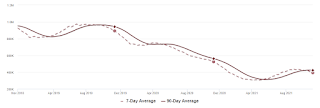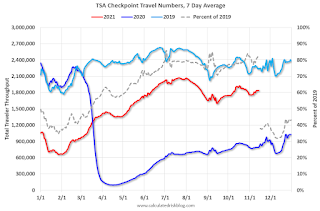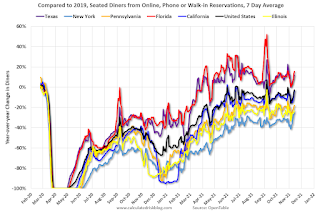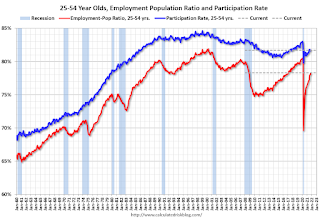by Calculated Risk on 11/16/2021 08:37:00 AM
Tuesday, November 16, 2021
Retail Sales Increased 1.7% in October
On a monthly basis, retail sales were increased 1.7% from September to October (seasonally adjusted), and sales were up 16.3 percent from October 2020.
From the Census Bureau report:
Advance estimates of U.S. retail and food services sales for October 2021, adjusted for seasonal variation and holiday and trading-day differences, but not for price changes, were $638.2 billion, an increase of 1.7 percent from the previous month, and 16.3 percent above October 2020.
emphasis added
 Click on graph for larger image.
Click on graph for larger image.This graph shows retail sales since 1992. This is monthly retail sales and food service, seasonally adjusted (total and ex-gasoline).
Retail sales ex-gasoline were up 1.5% in October.
The second graph shows the year-over-year change in retail sales and food service (ex-gasoline) since 1993.
 Retail and Food service sales, ex-gasoline, increased by 13.9% on a YoY basis.
Retail and Food service sales, ex-gasoline, increased by 13.9% on a YoY basis.Sales in October were above expectations, and sales in August and September were revised up.
Monday, November 15, 2021
Tuesday: Retail Sales, Industrial Production, Homebuilder Survey
by Calculated Risk on 11/15/2021 07:36:00 PM
From Matthew Graham at Mortgage News Daily: Upward Momentum Continues For Mortgage Rates
After hitting the lowest levels in over a month last Tuesday, mortgage rates have been moving higher fairly quickly each day since then. Most of the damage occurred on Wednesday and Friday of last week (markets were closed on Thursday), but today got progressively worse as the hours ticked by. [30 year fixed 3.23%]Tuesday:
emphasis added
• At 8:30 AM ET, Retail sales for October will be released. The consensus is for a 1.1% increase in retail sales.
• At 9:15 AM, The Fed will release Industrial Production and Capacity Utilization for October. The consensus is for a 0.7% increase in Industrial Production, and for Capacity Utilization to increase to 75.7%.
• At 10:00 AM, The November NAHB homebuilder survey. The consensus is for a reading of 80, unchanged from 80. Any number above 50 indicates that more builders view sales conditions as good than poor.
HUD: FHA'S 2021 Annual Report Shows Increase in Capital Reserves; DTI Remains Elevated
by Calculated Risk on 11/15/2021 04:49:00 PM
The U.S. Department of Housing and Urban Development (HUD) today released its fiscal year (FY) 2021 report to Congress on the financial health of the Federal Housing Administration (FHA) Mutual Mortgage Insurance Fund. In addition to its emphasis on delivering relief options to homeowners financially impacted by the COVID-19 pandemic, FHA continued to deliver on its mission of enabling homeownership for first-time and low- and moderate-income, and households of color.From the report: Credit scores are decent, but DTI ratio remains elevated.
The MMI Fund supports FHA’s Single Family mortgage insurance programs, including all forward mortgage purchase and refinance transactions, as well as mortgages insured under the Home Equity Conversion Mortgage (HECM) reverse mortgage program. The report illustrates that the MMI Fund increased its overall Capital Ratio, ending the fiscal year at 8.03 percent, an increase of 1.93 percentage points over the previous fiscal year. For the first time since 2015, the HECM reverse mortgage program has a strong positive ratio, primarily due to strong national home price appreciation. As the recovery from the pandemic continues, the Fund remains well positioned to withstand future economic events and endure the outcomes from the pandemic induced delinquencies that remain in forbearance or are seriously delinquent.
“The strength of the fund is a promising sign and solidifies the important role FHA fulfills in making homeownership a reality for first-time homebuyers and those with lower incomes.” said U.S. Department of Housing and Urban Development Secretary Marcia L. Fudge. “This year, our Administration took unprecedented steps to deliver relief to those devastated by the pandemic. Managing the strong fiscal health and performance of the FHA program is a top priority, and I am encouraged to see the MMI Fund remain resilient through the events of the past year. Looking ahead, we will ensure FHA is well positioned to provide broad and equitable access to homeownership, especially for those who have been historically underserved in the mortgage market.”
 Click on graph for larger image.
Click on graph for larger image.Exhibit III-8 above illustrates the distribution of credit scores for borrowers obtaining FHA endorsements. The share of endorsements with credit scores between 620 and 679 increased slightly in from 53.13 percent in FY 2020 to 57.16 percent in FY 2021. The share of endorsements on mortgages with credit scores of 720 or higher decreased from 14.69 percent in FY 2020 to 13.33 percent in FY 2021.

The average Debt-to-Income (DTI) ratio for borrowers with FHA-insured purchase mortgages increased slightly, from 43.08 percent in FY 2020 to 43.18 percent in FY 2021, as illustrated in Exhibit III-9 above. The percentage of borrowers with DTI ratios of 50 percent or greater in FY 2021 was at 23.71 percent, a decline from 24.20 percent in FY 2020 and a sign of slightly improving economic circumstances for FHA’s traditional borrowers.
November 15th COVID-19: New Cases Increasing, Above 80K per Day
by Calculated Risk on 11/15/2021 02:42:00 PM
| COVID Metrics | ||||
|---|---|---|---|---|
| Today | Week Ago | Goal | ||
| Percent fully Vaccinated | 58.8% | 58.4% | ≥70.0%1 | |
| Fully Vaccinated (millions) | 195.3 | 193.8 | ≥2321 | |
| New Cases per Day3🚩 | 80,823 | 72,204 | ≤5,0002 | |
| Hospitalized3 | 38,332 | 40,676 | ≤3,0002 | |
| Deaths per Day3 | 1,043 | 1,071 | ≤502 | |
| 1 Minimum to achieve "herd immunity" (estimated between 70% and 85%). 2my goals to stop daily posts, 37 day average for Cases, Currently Hospitalized, and Deaths 🚩 Increasing 7 day average week-over-week for Cases, Hospitalized, and Deaths ✅ Goal met. | ||||
IMPORTANT: For "herd immunity" most experts believe we need 70% to 85% of the total population fully vaccinated (or already had COVID). Note: COVID will probably stay endemic (at least for some time).
The following 19 states have between 50% and 59.9% fully vaccinated: Wisconsin at 59.0%, Nebraska, Iowa, Utah, Michigan, Texas, Kansas, Arizona, Nevada, South Dakota, North Carolina, Alaska, Ohio, Kentucky, Montana, Oklahoma, South Carolina, Missouri and Indiana at 50.3%.
Next up (total population, fully vaccinated according to CDC) are Georgia at 48.8%, Tennessee at 48.8%, Arkansas at 48.8%, Louisiana at 48.3% and North Dakota at 48.2%.
 Click on graph for larger image.
Click on graph for larger image.This graph shows the daily (columns) and 7 day average (line) of positive tests reported.
4th Look at Local Housing Markets in October
by Calculated Risk on 11/15/2021 01:26:00 PM
Today, in the Real Estate Newsletter: 4th Look at Local Housing Markets in October
Excerpt:
This is the fourth look at local markets in October. This update adds Des Moines, Maryland, South Carolina, and Washington, D.C..You can subscribe at https://calculatedrisk.substack.com/ (Currently all content is available for free, but please subscribe).
...
Here is a summary of active listings for the housing markets that have reported so far in October. For these markets, inventory was down 6.9% in October MoM from September, and down 25.2% YoY.
Of the markets that have reported so far, inventories in Jacksonville and San Diego are at record lows. Sacramento and Washington, D.C. are the only markets so far with inventory up YoY in October.
nventory almost always declines seasonally in October, so the MoM decline is not a surprise. Last month, these markets were down 23.1% YoY, so the YoY decline in October is slightly larger than in September. This is not indicating a slowing market.
Housing Inventory Nov 15th Update: Inventory Down 1.7% Week-over-week
by Calculated Risk on 11/15/2021 10:38:00 AM
Tracking existing home inventory will be very important this year.

This inventory graph is courtesy of Altos Research.
Seven High Frequency Indicators for the Economy
by Calculated Risk on 11/15/2021 08:26:00 AM
These indicators are mostly for travel and entertainment. It is interesting to watch these sectors recover as the pandemic subsides.
The TSA is providing daily travel numbers.
This data is as of November 14th.
 Click on graph for larger image.
Click on graph for larger image.This data shows the 7-day average of daily total traveler throughput from the TSA for 2019 (Light Blue), 2020 (Blue) and 2021 (Red).
The dashed line is the percent of 2019 for the seven day average.
The 7-day average is down 17.9% from the same day in 2019 (82.1% of 2019). (Dashed line)
The second graph shows the 7-day average of the year-over-year change in diners as tabulated by OpenTable for the US and several selected cities.
 Thanks to OpenTable for providing this restaurant data:
Thanks to OpenTable for providing this restaurant data:This data is updated through November 13, 2021.
This data is "a sample of restaurants on the OpenTable network across all channels: online reservations, phone reservations, and walk-ins. For year-over-year comparisons by day, we compare to the same day of the week from the same week in the previous year."
Note that this data is for "only the restaurants that have chosen to reopen in a given market". Since some restaurants have not reopened, the actual year-over-year decline is worse than shown.
Dining picked up for the Labor Day weekend, but declined after the holiday - and appears to be declining again. The 7-day average for the US is down 3% compared to 2019.
 This data shows domestic box office for each week and the median for the years 2016 through 2019 (dashed light blue).
This data shows domestic box office for each week and the median for the years 2016 through 2019 (dashed light blue). Note that the data is usually noisy week-to-week and depends on when blockbusters are released.
Movie ticket sales were at $151 million last week, down about 29% from the median for the week.
 This graph shows the seasonal pattern for the hotel occupancy rate using the four week average.
This graph shows the seasonal pattern for the hotel occupancy rate using the four week average. The red line is for 2021, black is 2020, blue is the median, dashed purple is 2019, and dashed light blue is for 2009 (the worst year on record for hotels prior to 2020).
This data is through November 6th. The occupancy rate was down 13.0% compared to the same week in 2019.
Notes: Y-axis doesn't start at zero to better show the seasonal change.
 This graph, based on weekly data from the U.S. Energy Information Administration (EIA), shows gasoline supplied compared to the same week of 2019.
This graph, based on weekly data from the U.S. Energy Information Administration (EIA), shows gasoline supplied compared to the same week of 2019.Blue is for 2020. Red is for 2021.
As of November 5th, gasoline supplied was down 0.7% compared to the same week in 2019.
There have been eight weeks so far this year when gasoline supplied was up compared to the same week in 2019 - and consumption is running close to 2019 levels now.
This graph is from Apple mobility. From Apple: "This data is generated by counting the number of requests made to Apple Maps for directions in select countries/regions, sub-regions, and cities." This is just a general guide - people that regularly commute probably don't ask for directions.
There is also some great data on mobility from the Dallas Fed Mobility and Engagement Index. However the index is set "relative to its weekday-specific average over January–February", and is not seasonally adjusted, so we can't tell if an increase in mobility is due to recovery or just the normal increase in the Spring and Summer.
 This data is through November 13th
This data is through November 13th The graph is the running 7-day average to remove the impact of weekends.
IMPORTANT: All data is relative to January 13, 2020. This data is NOT Seasonally Adjusted. People walk and drive more when the weather is nice, so I'm just using the transit data.
According to the Apple data directions requests, public transit in the 7 day average for the US is at 112% of the January 2020 level.
Here is some interesting data on New York subway usage (HT BR).
 This graph is from Todd W Schneider.
This graph is from Todd W Schneider. This data is through Friday, November 12th.
He notes: "Data updates weekly from the MTA’s public turnstile data, usually on Saturday mornings".
Sunday, November 14, 2021
Sunday Night Futures
by Calculated Risk on 11/14/2021 07:01:00 PM
Weekend:
• Schedule for Week of November 14, 2021
Monday:
• At 8:30 AM ET, The New York Fed Empire State manufacturing survey for November. The consensus is for a reading of 20.1, up from 10.5.
From CNBC: Pre-Market Data and Bloomberg futures S&P 500 are up 10 and DOW futures are up 67 (fair value).
Oil prices were down over the last week with WTI futures at $81.17 per barrel and Brent at $82.45 per barrel. A year ago, WTI was at $40, and Brent was at $42 - so WTI oil prices are up double year-over-year.
Here is a graph from Gasbuddy.com for nationwide gasoline prices. Nationally prices are at $3.40 per gallon. A year ago prices were at $2.12 per gallon, so gasoline prices are up $1.28 per gallon year-over-year.
The Labor Force Participation Rate
by Calculated Risk on 11/14/2021 02:13:00 PM
On Friday, Goldman Sachs economists put out a research note on the labor force participation rate: Why Isn’t Labor Force Participation Recovering?
While the unemployment rate continues to fall quickly, labor force participation has made no progress since August 2020. ... Most of the 5.0mn persons who have exited the labor force since the start of the pandemic are over age 55 (3.4mn), largely reflecting early (1.5mn) and natural (1mn) retirements that likely won’t reverse. The outlook for prime-age persons who have exited the labor force (1.7mn) is more positive, since very few are discouraged and most still view their exits as temporary.
The jobs number comes from Current Employment Statistics (CES: payroll survey), a sample of approximately 634,000 business establishments nationwide.
These are very different surveys: the CPS gives the total number of employed (and unemployed including the alternative measures), and the CES gives the total number of positions (excluding some categories like the self-employed, and a person working two jobs counts as two positions).
 Click on graph for larger image.
Click on graph for larger image.The Labor Force Participation Rate was unchanged at 61.6% in October, from 61.6% in September. This is the percentage of the working age population in the labor force.
The Employment-Population ratio increased to 58.8% from 58.7% (black line).
 Since the overall participation rate has declined due to the pandemic and demographic (aging population, younger people staying in school) reasons, here is the employment-population ratio for the key working age group: 25 to 54 years old.
Since the overall participation rate has declined due to the pandemic and demographic (aging population, younger people staying in school) reasons, here is the employment-population ratio for the key working age group: 25 to 54 years old.The 25 to 54 participation rate increased in October to 81.7% from 81.6% in September, and the 25 to 54 employment population ratio increased to 78.3% from 78.0% in September.
 Here is a graph of the change in the participation rate by age cohort (October 2019, October 2020, and October 2021 NSA).
Here is a graph of the change in the participation rate by age cohort (October 2019, October 2020, and October 2021 NSA).Saturday, November 13, 2021
Real Estate Newsletter Articles this Week
by Calculated Risk on 11/13/2021 02:11:00 PM
At the Calculated Risk Real Estate Newsletter this week:
• A Zillow Flip that Flopped
• Homebuilder Comments in October: “Builders are lifting sales caps" "Lack of lots & land development will hold back growth in 2022"
• 2nd Look at Local Housing Markets in October Inventory in San Diego is at an all time low
• Inventory will Tell the Tale
• "The deal of the Century ..." Best to all Veterans
• 3rd Look at Local Housing Markets in October Albuquerque, Atlanta, Colorado, Georgia, Houston, Jacksonville, Minnesota, Portland, Sacramento and Santa Clara
This will usually be published several times a week, and will provide more in-depth analysis of the housing market.
You can subscribe at https://calculatedrisk.substack.com/ Currently all content is available for free - and some will always be free - but please subscribe!.


